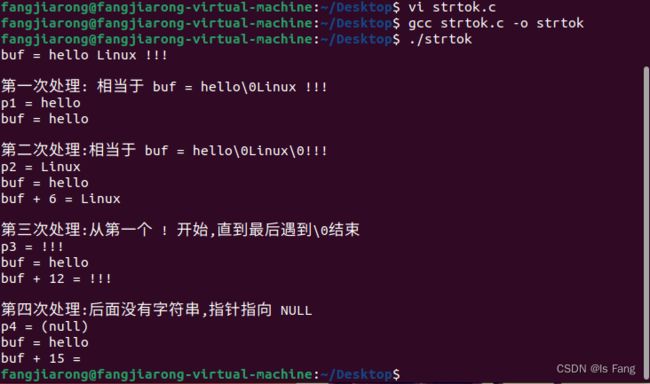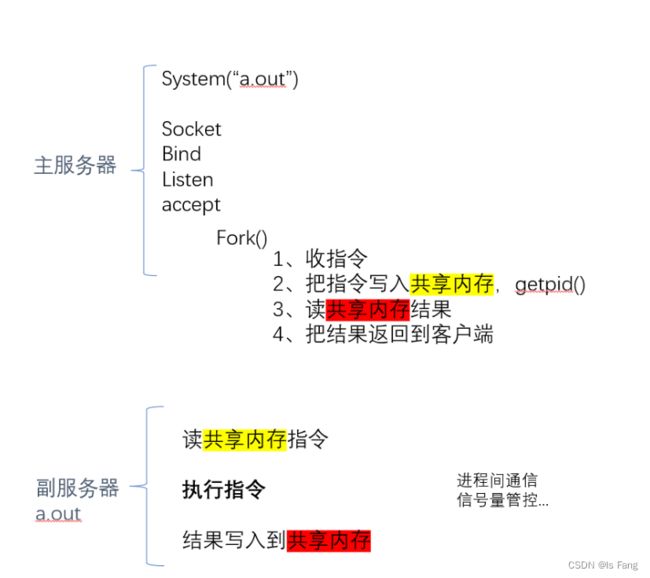Linux 网络编程项目 —— FTP 网盘
文章目录
- 项目简介
- 知识点描述
- 项目功能指令
-
- 远程功能指令
- 本地功能指令
- 使用的关键函数
-
- access 函数
- popen 函数
- chdir 函数
- strtok 函数
- strncmp 函数
- linux system函数是否执行成功判断方法
- 基本流程
-
- 服务端
- 客户端
- FTP代码实例
-
- 头文件 ftp.h
- 客户端 client.c
- 服务端 server.c
- V2.0版 – 启用副服务器
项目简介
- FTP服务器(File Transfer Protocol Server)是在互联网上提供文件存储和访问服务的计算机,它们依照FTP协议提供服务。 FTP是File Transfer Protocol(文件传输协议)。
- 这个项目分成ftp客户端及服务端,实现的功能和Linux开源的 FTP 服务器类似,客戶端通过网络,远程获取服务端磁盘上的文件夹内容,下载文件,上传文件等功能。
知识点描述
-
FTP服务器用到的是Socket网络通信,当收到客户端接入的时候,服务器创建子进程对接连接,子进程启动后分析来自客户端的指令,服务端可同时处理多个客户端接入并对指令作出解析,并把执行结果返回给客户端。比如:收到get file1的指令,是客户端想要获取file1文件的,我先用strstr()函数进行字符串分割,获取到文件名,在判断文件是否存在,如果文件存在,就读取文件內容,再将內容通过套接字发给客户端,客户端收到数据后,创建文件,并将收到的数据写入文件,完成文件的远程下载。
-
上传文件和下载文件类似,主要还是涉及文件的操作,字符串的操作,以及网络编程。
-
还支持了Is、pwd、cd等Linux系统常用的指令。普通指令的实现用popen来调用系统指令,并读取执行的结构。如果不需要获取执行结果,用system函数调用就可以了。
项目功能指令
远程功能指令
- LS —— 展示服务端文件,用法:ls
- PWD —— 展示服务端的当前路径,用法:pwd
- CD —— 用于切换服务端的路径,用法:cd path
- RM —— 用于删除服务端的文件,用法:rm file
- GET —— 下载服务端文件至客户端本地,用法:get file
- PUT —— 把客户端本地文件上传至服务端,用法:put file
本地功能指令
- LLS —— 展示客户端本地文件,用法:lls
- LPWD —— 展示客户端当前路径,用法:lpwd
- LCD —— 用于切换客户端本地的路径,用法:lcd path
- LRM —— 用于删除客户端本地的文件:用法:lrm file
- QUIT —— 用于客户端的退出,用法:quit
使用的关键函数
access 函数
int access(const char *pathname, int mode);
功能:判断文件是否存在
参数1:
- 文件名字
参数2:(这里用F_OK)
- R_OK 只判断是否有读权限
- W_OK 只判断是否有写权限
- X_OK 判断是否有执行权限
- F_OK 只判断是否存在
返回值:
- 不存在返回-1
popen 函数
FILE *popen(const char *command, const char *type);
int pclose(FILE *stream); //打开后要用 pclose 关闭文件
功能:可以像打开文件一样打开 shell 指令。后续可以使用 fread 读取内容到缓冲区 buf
参数1:
- shell 指令
参数2:
- r 或者 w ,一般都是 r
注意:
- popen与system的区别:popen可以将返回的结果写在文件中,system只能执行指令,返回成功与否
- popen返回的是文件流,可以通过fread读取文件流可以写入到指定缓冲区,指令LS PWD需要用到该函数
- system 函数直接返回结果到控制台,指令LLS LPWD 可以使用该函数,在客户端直接展示
- RM LRM 指令因为处理完不需要看到文件情况,所以也可以直接调用 system 函数来处理,处理完成后只需要提醒客户端再次输入 LS 或者 LLS 即可查看文件变动情况。
chdir 函数
int chdir(const char *path);
功能:跳转至以参数path 指定目录
参数:
- 指向目标目录的指针
返回值执:
- 成功则返回0,
- 失败返回-1, errno 为错误代码.
注意:
- 为什么不直接调用 system 函数来跳转目录呢?因为调用 system 函数相当于 fork 出一个子进程来处理跳转目录,子进程执行了 cd 命令后改变了自己的 pwd, 但是子进程执行完后会消亡,而父进程的路径没有改变,所以不能使用 system 函数来跳转目录。
strtok 函数
char *strtok(char *str, const char *delim);
功能:字符串分隔,把参数二的字符修改为’\0’,返回其前面的字符串地址。
参数1:
- 要分割的字符串
参数2:
- 分隔字符
- 指定临界点
#include strncmp 函数
int strcmp(const char *s1, const char *s2);
int strncmp(const char *s1, const char *s2, size_t n);
功能:字符串比较。strncmp能够精确判断字符的个数
参数1:
- 比较字符串1
参数2:
- 比较字符串2
参数3:
- 比较前几个是否一样
返回值:
- 一样返回0,
- 不一样非0
注意:
- 为什么不用 strcmp,因为 strcmp 在判断一些需要带有文件名的指令时,如(cd xxx)不能准确判断,而 strncmp 可以准确判断前面指令的字符个数,不易出错。
- 还有一种方案是用 strstr 函数,查看命令中是否含有特殊的指令来判断也可以。
linux system函数是否执行成功判断方法
参考博文:linux system函数是否执行成功判断方法
基本流程
服务端
- socket 创建服务端的套接字
- bind 端口号和 IP 地址
- listen 监听客户端的连接
- accept 接受客户端的接入
- fork 创建子进程处理客户端操作
- read 接收客户端发送的 cmd
- 服务端开始处理从客户端接收到的 cmd
- write 服务端处理完的 data 到客户端
客户端
- socket 创建客户端的套接字
- connect 连接上服务端,配置端口号和 IP 地址
- 连接成功后,获取用户键盘输入,处理输入命令 cmd
- write 客户端的 cmd 到服务端
- read 服务端处理完返回的 data
FTP代码实例
头文件 ftp.h
#define LS 0
#define LLS 1
#define PWD 2
#define CD 3
#define RM 5
#define GET 6
#define PUT 7
#define LPWD 8
#define LCD 9
#define LRM 10
#define QUIT 120
struct myFTP
{
int set; // 客户端返回给服务器的宏命令
int mark; // 判断文件是否存在的标识
char cmd[128]; // 用户输入的命令
char data[1024]; // 存放根据指令进行相关读取操作的 结果
};
客户端 client.c
#include "ftp.h"
#include 服务端 server.c
#include "ftp.h"
#include 执行校验:
md5sum test.txt
#注1:结果为1行2列。第一列是md5值,第二列是md5值对应的文件名
- md5sum命令采用MD5报文摘要算法(128位)计算和检查文件的校验和。
- 一般来说,安装了Linux后,就会有md5sum这个工具,直接在命令行终端直接运行。
- linux中每个文件都会有1个md5值。当两个文件的md5值相同,表示这两个文件完全相同。

